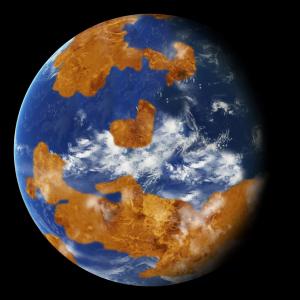The planet Venus is hot and dry, but research suggests that in the distant past it could have been much more hospitable, with oceans of liquid water covering much of the planet, as shown in this artist's concept. Some researchers suggest that as Venus's surface got hotter, microscopic organisms could have adapted to live in the planet's clouds. Such microbes could still inhabit the clouds today. [NASA]
You are here
Moon and Venus
Venus is just about the most inhospitable place you can imagine. Its surface is hot enough to melt lead, the air is toxic, and the pressure is like being more than half a mile down in Earth’s oceans. And to top it all off, the planet’s clouds are made of sulfuric acid.
For the last half-century, though, scientists have speculated that microscopic life could exist in those clouds -- about 30 miles above the surface.
Although Venus is hellish today, it once was much more comfortable. Water could have covered its surface for up to two billion years. That’s plenty of time for life to develop. And as the water vanished and the planet heated up, some of that life could have been wafted into the clouds.
Here on Earth, microbes have adapted to live just about anywhere. That includes environments that are highly acidic, like Venus’s clouds. If life can adapt to extreme environments on Earth, it’s possible it could do so on Venus, too.
Observations of the clouds have shown dark patches that come and go. A recent study speculated that they could be like red tides here on Earth -- massive blooms of microscopic organisms.
The only way to know for sure is to sample the clouds with instruments that can look for life -- something that’s not likely to happen for a long time.
For now, we can enjoy looking at Venus, the brilliant “evening star.” Tonight, Venus is close to the crescent Moon. It’s a deadly world with a beautiful appearance.
Get Premium Audio
Listen to today's episode of StarDate on the web the same day it airs in high-quality streaming audio without any extra ads or announcements. Choose a $8 one-month pass, or listen every day for a year for just $30.






